Focus Chinese Taoist | Country of origin China | |
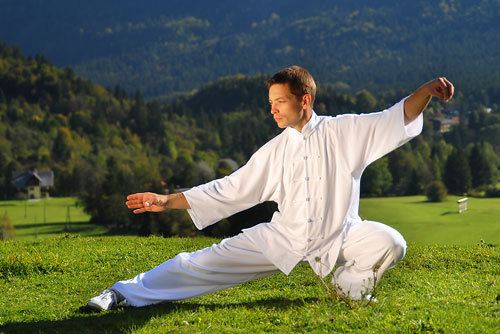 | ||
Also known as Taijizhang;
t‘ai-chi; taiji Hardness Forms competition,
Light contact (pushing hands, no strikes),
Full contact (strikes, kicks, throws, etc.) Creator Said to be Zhang Sanfeng Famous practitioners Chen Wangting,
Chen Changxing,
Chen Fake,
Yang Lu-ch'an,
Yang Chengfu,
Wu Ch'uan-yu,
Wu Chien-ch'uan,
Wu Yu-hsiang,
Sun Lu-t'ang,
Wang Pei-sheng | ||
Tai chi vs boxing
T‘ai-chi (Mandarin: tàijí 太極, an abbreviation of tàijí quán 太極拳, literally "Supreme Ultimate Boxing") is an internal Chinese martial art 武术 practiced for both its defense training and its health benefits. Though originally conceived as a martial art, it is also typically practiced for a variety of other personal reasons: competitive wrestling in the format of pushing hands (tui shou), demonstration competitions, and achieving greater longevity. As a result, a multitude of training forms exist, both traditional and modern, which correspond to those aims with differing emphasis. Some training forms of t‘ai-chi ch‘üan are especially known for being practiced with relatively slow movements.
Contents
- Tai chi vs boxing
- Tai chi applications demonstration by grandmaster wang xi an
- Overview
- Name
- Historical origin
- History and styles
- Differences between Chen Yang and Wu styles
- Reasons for differences
- Tai chi chan in the United States
- Tai chi chan lineage tree
- Modern forms
- Tai chi chan today
- Tai chi chan as sport
- Philosophy
- Training and techniques
- Forms
- Solo taolu neigong and qigong
- Qigong versus tai chi chan
- Partnered tuishou and sanshou
- Weapons
- Health
- Historic and legendary confrontations
- Attire and ranking
- Tai Chi as a generic brand
- References

Today, t‘ai-chi ch‘üan has spread worldwide. Most modern styles of t‘ai-chi ch‘üan trace their development to at least one of the five traditional schools: Chen, Yang, Wu (Hao), Wu, and Sun. All of the former, in turn, trace their historical origins to Chen Village.
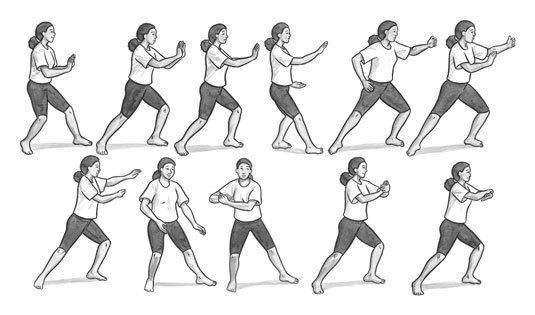
Tai chi applications demonstration by grandmaster wang xi an
Overview

The concept of the taiji ("supreme ultimate"), in contrast with wuji ("without ultimate"), appears in both Taoist and Confucian Chinese philosophy, where it represents the fusion or mother of yin and yang into a single ultimate, represented by the taijitu symbol . T‘ai-chi ch‘üan theory and practice evolved in agreement with many Chinese philosophical principles, including those of Taoism and Confucianism.

T‘ai-chi ch‘üan training involves five elements, taolu (solo hand and weapons routines/forms), neigong and qigong (breathing, movement and awareness exercises and meditation), tuishou (response drills) and sanshou (self defence techniques). While t‘ai-chi ch‘üan is typified by some for its slow movements, many t‘ai-chi styles (including the three most popular—Yang, Wu and Chen) have secondary forms with faster pace. Some traditional schools of t‘ai-chi teach partner exercises known as tuishou (pushing hands), and martial applications of the postures of different forms (taolu).
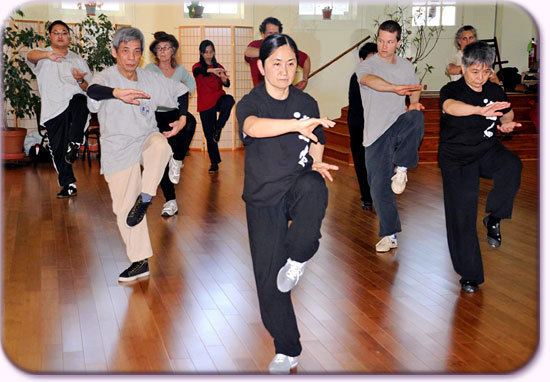
In China, t‘ai-chi ch‘üan is categorized under the Wudang grouping of Chinese martial arts—that is, the arts applied with internal power. Although the term Wudang suggests these arts originated in the Wudang Mountains, it is simply used to distinguish the skills, theories and applications of neijia (internal arts) from those of the Shaolin grouping, or waijia (hard or external) styles.
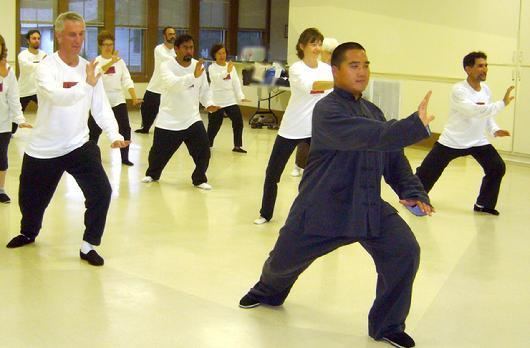
Since the earliest widespread promotion of the health benefits of t‘ai-chi ch‘üan, by Yang Shaohou, Yang Chengfu, Wu Chien-ch‘üan and Sun Lutang in the early 20th century, it has developed a worldwide following of people, often with little or no interest in martial training, for its benefit to personal health. Medical studies of t‘ai-chi support its effectiveness as an alternative exercise and a form of martial arts therapy.
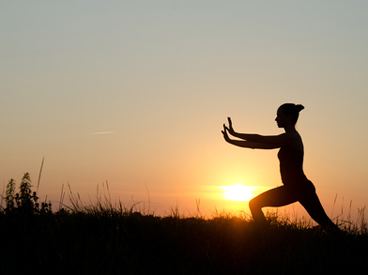
It is purported that focusing the mind solely on the movements of the form helps to bring about a state of mental calm and clarity. Besides general health benefits and stress management attributed to t‘ai-chi ch‘üan training, aspects of traditional Chinese medicine are taught to advanced t‘ai-chi ch‘üan students in some traditional schools.
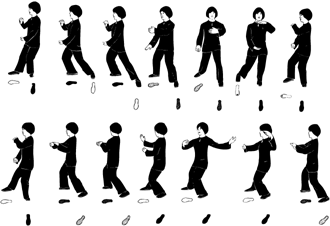
Some other forms of martial arts require students to wear a uniform during practice. In general, t‘ai-chi ch‘üan schools do not require a uniform, but both traditional and modern teachers often advocate loose, comfortable clothing and flat-soled shoes.
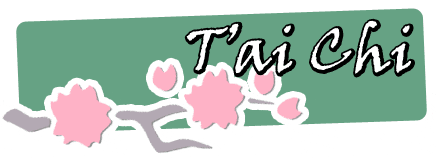
The physical techniques of t‘ai-chi ch‘üan are described in the "T‘ai-chi classics," a set of writings by traditional masters, as being characterized by the use of leverage through the joints based on coordination and relaxation, rather than muscular tension, in order to neutralize, yield or initiate attacks. The slow, repetitive work involved in the process of learning how that leverage is generated gently and measurably increases, opens the internal circulation (breath, body heat, blood, lymph, peristalsis, etc.).
The study of t‘ai-chi ch‘üan primarily involves three aspects:
Name
The names T‘ai-chi ch‘üan and Taiji quan are two different transcriptions of three Chinese characters that are the written Chinese name for the artform:
Despite the one Chinese spelling, 太極拳, there are two different spellings in the English usage, one derived from the Wade–Giles and the other from the Pinyin transcription, with the West being most familiar with the Wade–Giles: t‘ai-chi ch‘üan. Westerners often shorten this name to t‘ai chi (often omitting the aspirate sign—thus becoming "tai chi"). This shortened name is the same as that of the t‘ai-chi philosophy, sometimes causing confusion of the two. The chi in the name of the martial art may also be mistaken for ch‘i, (qi — 氣) the "life force," especially as ch‘i is involved in the practice of t‘ai-chi ch‘üan. The Wade-Giles form and its variations remain the most popular spelling today; however, most Chinese, including many professional practitioners, masters, and martial arts bodies (such as the IWUF), use the Pinyin.
Historical origin
From a modern historical perspective, when tracing t‘ai-chi ch‘üan's formative influences to Taoist and Buddhist monasteries, there seems little more to go on than legendary tales. Nevertheless, some traditional schools claim that t‘ai-chi ch‘üan has a practical connection to and dependence upon the theories of Song dynasty Neo-Confucianism (a conscious synthesis of Taoist, Buddhist, and Confucian traditions, especially the teachings of Mencius). These schools believe that t‘ai-chi ch‘üan's theories and practice were formulated by the Taoist monk Zhang Sanfeng in the 12th century, at about the same time that the principles of the Neo-Confucian school were making themselves felt in Chinese intellectual life. However, modern research casts serious doubts on the validity of those claims, pointing out that a 17th-century piece called "Epitaph for Wang Zhengnan" (1669), composed by Huang Zongxi (A.D. 1610–1695), is the earliest reference indicating any connection between Zhang Sanfeng and martial arts whatsoever, and must not be taken literally but must be understood as a political metaphor instead. Claims of connections between t‘ai-chi ch‘üan and Zhang Sanfeng appeared no earlier than the 19th century.
History records that Yang Luchan trained with the Chen family for 18 years before he started to teach the art in Beijing, which strongly suggests that his art was based on, or heavily influenced by, the Chen family art. The Chen family are able to trace the development of their art back to Chen Wangting in the 17th century. Martial arts historian Xu Zhen believed that the Taiji of Chen Village had been influenced by the Taizu changquan style practiced at the nearby Shaolin Monastery, while Tang Hao thought it was derived from a treatise by the Ming dynasty general Qi Jiguang, Jixiao Xinshu (New Treatise on Military Efficiency), which discussed several martial arts styles including Taizu changquan.
What is now known as "t‘ai-chi ch‘üan" appears to have received this appellation from only around the mid-1800s. A scholar in the Imperial Court by the name of Ong Tong He witnessed a demonstration by Yang Luchan at a time before Yang had established his reputation as a teacher. Afterwards Ong wrote: "Hands holding Taiji shakes the whole world, a chest containing ultimate skill defeats a gathering of heroes." Before this time the art may have had a number of different names, and appears to have been generically described by outsiders as zhan quan (沾拳, touch boxing), Mian Quan (soft boxing) or shisan shi (十三式, the thirteen techniques).
History and styles
There are five major styles of t‘ai-chi ch‘üan, each named after the Chinese family from which it originated:
The order of verifiable age is as listed above. The order of popularity (in terms of number of practitioners) is Yang, Wu, Chen, Sun and Wu/Hao. The major family styles share much underlying theory, but differ in their approaches to training.
There are now dozens of new styles, hybrid styles, and offshoots of the main styles, but the five family schools are the groups recognized by the international community as being the orthodox styles. Other important styles are Zhaobao t‘ai-chi ch‘üan, a close cousin of Chen-style, which has been newly recognized by Western practitioners as a distinct style, the Fu style, created by Fu Chen Sung, which evolved from Chen, Sun and Yang styles, and also incorporates movements from Baguazhang (Pa Kua Chang) and the Cheng Man-ch'ing style which is a simplification of the traditional Yang style.
Most existing styles can be traced back to the Chen-style, which had been passed down as a family secret for generations. The Chen family chronicles record Chen Wangting, of the family's 9th generation, as the inventor of what is known today as t‘ai-chi ch‘üan. Yang Luchan became the first person outside the family to learn t‘ai-chi ch‘üan. His success in fighting earned him the nickname Yang Wudi, which means "Unbeatable Yang", and his fame and efforts in teaching greatly contributed to the subsequent spreading of t‘ai-chi ch‘üan knowledge.
Differences between Chen, Yang and Wu styles
Chen-style is the original tai chi style. Yang-style was later derived from Chen, and Yang in turn spawned Wu-style. It is thus useful to compare the three.
Differences can be relatively minor and include the speed at which motions are performed, the order of poses, the size of the movements, and hand orientation. A larger difference is the way in which the movements are performed. For example, the form "Parting the wild horse's mane" in Yang-style bears no resemblance to the same movement in Sun-style, and the Sun 73 forms can be performed in the same time as the Yang 24 forms. Differences also exist within the same style: depending on the teacher's lineage, Yang Short Form can be counted as 103, 108 or 122 separate poses.
Tempo
Size of movement
Reasons for differences
Yang Luchan, founder of Yang-style, originally taught Chen-style as he had learned. Over time, he reasoned that when fighting, people did not adopt the deep stances taught—thus he raised the stance. Movements slowed as it was easier to speed-up a correct movement performed slowly than to increase precision in a fast movement.
Chen-style was developed for use against armoured opponents. Yang-style was developed when use of armour had decreased (and additional changes were introduced in the early 20th century by Yang Cheng Fu). Wu-style is even more remote from armour.
In order to make the style easier to learn, the Yang Short Form was developed which incorporates around 100 postures, as opposed to around 300 of the long form. New Zealand t‘ai-chi teacher Hu Loo-Chi (who taught Chen-style) said the 84 postures could be learnt in around 14 hours, though it would take a lifetime to master them.
Over time, unintentional differences may accumulate in the way a style is taught by a particular teacher or school. Periodically, some teachers may update or amend their teaching after studying with the current lineage holder or another teacher closer to the lineage holder. This serves to correct any errors that may have arisen in transmission of the style, as well as incorporating changes made by the current lineage holder. Without a formal system of accreditation or standardization, such refreshment is optional. This accumulation of errors as well as personal preference by the teacher accounts for variation in styles.
T‘ai-chi ch‘üan in the United States
Choy Hok Pang, a disciple of Yang Chengfu, was the first known proponent of t‘ai-chi ch‘üan to openly teach in the United States in 1939. Subsequently, his son and student Choy Kam Man emigrated to San Francisco from Hong Kong in 1949 to teach t‘ai-chi ch‘üan in San Francisco's Chinatown. Choy Kam Man taught until he died in 1994.
Sophia Delza, a professional dancer and student of Ma Yueliang, performed the first known public demonstration of t‘ai-chi ch‘üan in the United States at the Museum of Modern Art in New York City in 1954. She also wrote the first English language book on t‘ai-chi, t‘ai-chi ch‘üan: Body and Mind in Harmony, in 1961. She taught regular classes at Carnegie Hall, the Actors Studio, and the United Nations.
Another early practitioner of t‘ai-chi ch‘üan to openly teach in the United States was Zheng Manqing, who opened his school Shr Jung t‘ai-chi after he moved to New York from Taiwan in year 1964. Unlike the older generation of t‘ai-chi practitioners, Zheng was cultured and educated in American ways, and thus he was able to transcribe Yang's dictation into a written manuscript that became the de facto manual for Yang style t‘ai-chi. Zheng felt Yang's traditional 108-movement Long Form was unnecessarily long and repetitive, which makes it difficult to learn and make progress. He thus created a shortened 37-movement version and taught that in his schools. Zheng's form became very popular and was the dominant form in the New York-Philadelphia-Washington DC corridor until other teachers started to emigrate to the United States in larger numbers in the 90's. He taught until his death in 1975.
T‘ai-chi ch‘üan lineage tree
Note:
Modern forms
The Cheng Man-ch‘ing (Zheng Manqing) and Chinese Sports Commission short forms are derived from Yang family forms, but neither is recognized as Yang family t‘ai-chi ch‘üan by standard-bearing Yang family teachers. The Chen, Yang, and Wu families are now promoting their own shortened demonstration forms for competitive purposes.
T‘ai-chi ch‘üan today
In the last twenty years or so, t‘ai-chi ch‘üan classes that purely emphasise health have become popular in hospitals, clinics, as well as community and senior centres. This has occurred as the baby boomers generation has aged and the art's reputation as a low-stress training method for seniors has become better known.
As a result of this popularity, there has been some divergence between those that say they practice t‘ai-chi ch‘üan primarily for self-defence, those that practice it for its aesthetic appeal (see wushu below), and those that are more interested in its benefits to physical and mental health. The wushu aspect is primarily for show; the forms taught for those purposes are designed to earn points in competition and are mostly unconcerned with either health maintenance or martial ability. More traditional stylists believe the two aspects of health and martial arts are equally necessary: the yin and yang of t‘ai-chi ch‘üan. The t‘ai-chi ch‘üan "family" schools, therefore, still present their teachings in a martial art context, whatever the intention of their students in studying the art.
T‘ai-chi ch‘üan as sport
In order to standardize t‘ai-chi ch‘üan for wushu tournament judging, and because many t‘ai-chi ch‘üan teachers have either moved out of China or had been forced to stop teaching after the Communist regime was established in 1949, the government sponsored the Chinese Sports Committee, who brought together four of their wushu teachers to truncate the Yang family hand form to 24 postures in 1956. They wanted to retain the look of t‘ai-chi ch‘üan, but create a routine that would be less difficult to teach and much less difficult to learn than longer (in general, 88 to 108 posture), classical, solo hand forms. In 1976, they developed a slightly longer form also for the purposes of demonstration that still would not involve the complete memory, balance, and coordination requirements of the traditional forms. This became the Combined 48 Forms that were created by three wushu coaches, headed by Men Hui Feng. The combined forms were created based on simplifying and combining some features of the classical forms from four of the original styles: Chen, Yang, Wu, and Sun. As t‘ai-chi ch‘üan again became popular on the mainland, more competitive forms were developed to be completed within a six-minute time limit. In the late 1980s, the Chinese Sports Committee standardized many different competition forms. They developed sets to represent the four major styles as well as combined forms. These five sets of forms were created by different teams, and later approved by a committee of wushu coaches in China. All sets of forms thus created were named after their style, e.g., the "Chen-style national competition form" is the 56 Forms, and so on. The combined forms are The 42-Form or simply the Competition Form. Another modern form is the "97 movements combined t‘ai-chi ch‘üan form", created in the 1950s; it contains characteristics of the Yang, Wu, Sun, Chen, and Fu styles blended into a combined form. The wushu coach Bow Sim Mark is a notable exponent of the "67 combined form".
These modern versions of t‘ai-chi ch‘üan (often listed as the pinyin romanization "taijiquan" among practitioners, teachers and masters) have since become an integral part of international wushu tournament competition, and have been featured in popular movies, starring or choreographed by well-known wushu competitors, such as Jet Li and Donnie Yen.
In the 11th Asian Games of 1990, wushu was included as an item for competition for the first time with the 42-Form being chosen to represent t‘ai-chi ch‘üan. The International Wushu Federation (IWUF) applied for wushu to be part of the Olympic games, but will not count medals.
Practitioners also test their practical martial skills against students from other schools and martial arts styles in tuishou (pushing hands) and sanshou competition.
Philosophy
The philosophy of t‘ai-chi ch‘üan is that, if one uses hardness to resist violent force, then both sides are certainly to be injured at least to some degree. Such injury, according to t‘ai-chi ch‘üan, is a natural consequence of meeting brute force with brute force. Instead, students are taught not to directly fight or resist an incoming force, but to meet it in softness and follow its motion while remaining in physical contact until the incoming force of attack exhausts itself or can be safely redirected, meeting yang with yin. When done correctly, this yin/yang or yang/yin balance in combat, or in a broader philosophical sense, is a primary goal of t‘ai-chi ch‘üan training. Lao Tzŭ provided the archetype for this in the Tao Te Ching when he wrote, "The soft and the pliable will defeat the hard and strong."
Traditional schools also emphasize that one is expected to show wude ("martial virtue/heroism"), to protect the defenseless, and show mercy to one's opponents.
Training and techniques
The core training involves two primary features: the first being taolu (solo "forms"), a slow sequence of movements which emphasize a straight spine, abdominal breathing and a natural range of motion; the second being different styles of tuishou ("pushing hands") for training movement principles of the form with a partner and in a more practical manner.
Forms
Solo (taolu, neigong and qigong)
The taolu (solo "forms") should take the students through a complete, natural range of motion over their centre of gravity. Accurate, repeated practice of the solo routine is said to retrain posture, encourage circulation throughout the students' bodies, maintain flexibility through their joints, and further familiarize students with the martial application sequences implied by the various forms. The major traditional styles of t‘ai-chi have forms that differ somewhat in terms of aesthetics, but there are also many obvious similarities that point to their common origin. The solo forms—empty-hand and weapon—are catalogues of movements that are practised individually in pushing hands and martial application scenarios to prepare students for self-defence training. In most traditional schools, different variations of the solo forms can be practised: fast / slow, small-circle / large-circle, square / round (which are different expressions of leverage through the joints), low-sitting / high-sitting (the degree to which weight-bearing knees are kept bent throughout the form), for example.
Breathing exercises; neigong (internal skill) or, more commonly, qigong (life energy cultivation) are practiced to develop qi (life energy) in coordination with physical movement and zhan zhuang (standing like a post) or combinations of the two. These were formerly taught only to disciples as a separate, complementary training system. In the last 60 years they have become better known to the general public.
Qigong versus t‘ai-chi ch‘üan
Qigong involves coordinated movement, breath, and awareness used for health, meditation, and martial arts training. While many scholars and practitioners consider t‘ai-chi ch‘üan to be a type of qigong, the two are commonly distinguished as separate but closely related practices, with qigong playing an important role in training for t‘ai-chi ch‘üan, and with many t‘ai-chi ch‘üan movements performed as part of qigong practice. The focus of qigong is typically more on health or meditation than martial applications. Internally the main difference is the flow of Qi, In qigong the flow of Qi is held at a gate point for a moment to aid the opening and cleansing of the channels. In Taiji the flow of Qi is continuous, thus allowing the development of Power for the use by the practitioner, thus the differences between postures, i.e.: no straighting of joint in Taiji.
Partnered (tuishou and sanshou)
T‘ai-chi ch‘üan's martial aspect relies on sensitivity to the opponent's movements and centre of gravity dictating appropriate responses. Effectively affecting or "capturing" the opponent's centre of gravity immediately upon contact, is trained as the primary goal of the martial t‘ai-chi ch‘üan student. The sensitivity needed to capture the centre is acquired over thousands of hours of first yin (slow, repetitive, meditative, low-impact) and then later adding yang (realistic, active, fast, high-impact) martial training through taolu (forms), tuishou (pushing hands), and sanshou (sparring). T‘ai-chi ch‘üan trains in three basic ranges: close, medium and long, and then everything in between. Pushes and open-hand strikes are more common than punches, and kicks are usually to the legs and lower torso, never higher than the hip, depending on style. The fingers, fists, palms, sides of the hands, wrists, forearms, elbows, shoulders, back, hips, knees, and feet are commonly used to strike, with strikes to the eyes, throat, heart, groin, and other acupressure points trained by advanced students. Chin na, which are joint traps, locks, and breaks are also used. Most t‘ai-chi ch‘üan teachers expect their students to thoroughly learn defensive or neutralizing skills first, and a student will have to demonstrate proficiency with them before offensive skills will be extensively trained.
In addition to the physical form, martial t‘ai-chi ch‘üan schools also focus on how the energy of a strike affects the other person. A palm strike that looks to have the same movement may be performed in such a way that it has a completely different effect on the target's body. A palm strike that could simply push the opponent backward, could instead be focused in such a way as to lift the opponent vertically off the ground, breaking his/her centre of gravity; or that it could terminate the force of the strike within the other person's body with the intent of causing internal damage.
Most aspects of a trainee's t‘ai-chi ch‘üan development are meant to be covered within the partnered practice of tuishou, and so, sanshou (sparring) is not as commonly used as a method of training, but more advanced students sometimes do practice by sanshou. Sanshou is more common to tournaments such as wushu tournaments.
Weapons
Variations of t‘ai-chi ch‘üan involving weapons also exist such as taijijian. The weapons training and fencing applications employ:
More exotic weapons still used by some traditional styles include:
Health
T‘ai-chi ch‘üan has been reported as being useful in treating a number of human ailments, and is supported by a number of associations, including the National Parkinson Foundation and Diabetes Australia. However, medical evidence of effectiveness was lacking and in recent years research has been undertaken to address this.
A 2011 comprehensive overview of all the existing systematic reviews of t‘ai-chi ch‘üan's health effects found that "the evidence is conclusively or tentatively positive for fall prevention, general healthcare in older people, improving balance and enhancing psychological health"; the overview's authors thus recommended t‘ai-chi ch‘üan to older people for its various physical and psychological benefits. There was no conclusive evidence of benefit for any of the other conditions researched, including Parkinson's disease, diabetes, cancer and arthritis.
A 2015 systematic review found Tai Chi could be performed by those with chronic medical conditions such as chronic obstructive pulmonary disease, heart failure, and osteoarthritis without worsening shortness of breath and pain, and found favorable effects on functional exercise capacity in people with these conditions.
In 2015 the Australian Government's Department of Health published the results of a review of alternative therapies that sought to determine if any were suitable for being covered by health insurance; t‘ai-chi was one of 17 therapies evaluated for which no clear evidence of effectiveness was found.
Historic and legendary confrontations
Attire and ranking
In practice traditionally there is no specific uniform required in the practice of t‘ai-chi ch‘üan. Modern day practitioners usually wear comfortable, loose T-shirts and trousers made from breathable natural fabrics, that allow for free movement during practice. Despite this, t‘ai-chi ch‘üan has become synonymous with "t‘ai-chi uniforms" or "kung fu uniforms" that usually consist of loose-fitting traditional Chinese styled trousers and a long or short-sleeved shirt, with a Mandarin collar and buttoned with Chinese frog buttons. The long-sleeved variants are referred to as Northern-style uniforms, whilst the short-sleeved, Southern-style uniforms. The colour of this clothing is usually, all white, all black, black & white, or any other colour, mostly being either all a single solid colour or a combination of 2 colours: one colour being the actual clothing and the binding being a contrasting colour. They are normally made from natural fabrics such as cotton or silk. These uniforms are not a requirement, but rather are usually worn by masters & professional practitioners during demonstrations, tournaments and other public exhibitions.
There is no standardized t‘ai-chi ch‘üan ranking system, except the Chinese Wushu Duan wei exam system run by the Chinese wushu association in Beijing. However, most schools do not use belt rankings. Some schools may present students with belts depicting rank, similar to dans in Japanese martial arts. A simple uniform element of respect and allegiance to one's teacher and their methods and community, belts also mark hierarchy, skill, and accomplishment of practice in one school's style and system. During wushu tournaments, masters and grandmasters often wear "kung fu uniforms" which tend to have no belts. Wearing a belt signifying rank in such a situation would be unusual.
Tai Chi as a generic brand
From roughly the mid-1990s onward, Tai Chi has gained a popularity in some countries to the point of it becoming nearly as known as a health-oriented practice as Yoga. In fact, in modern times it is even more known for such benefits and methods of practice than it is known for its original purpose - a martial art. Thus, the term 'Tai Chi' has become synonymous in the public view with the notion of being a health-oriented pastime (often perceived as fit more for elderly people), both in China and the West. This commonly held view has served many to take advantage of the term 'Tai Chi' as a generic business brand, specifically in the Fitness Industry.
A new phenomenon (since the 2000s) is of various martial arts styles claiming a historical relationship or otherwise with Taiji Quan, because of its popularity. A branch of Lama Pai known as 'Tibetan White Crane' had popularized a slow-movement form by naming it 'Needle in Cotton' (a common term describing Taiji Quan mechanics), and referring to its practice as 'Tai Chi'. However, there is no relationship between these arts, historic or otherwise. A similar phenomenon occurs with the usage of the art's name as a universal brand for promoting various fitness programs, books and videos. There is, for instance, a book that describes how to use the training principles of Tai Chi to run better. Regardless of the questions of whether such claims are viable, these are all new trends, which historically were not endorsed or promoted by teachers of the art.
